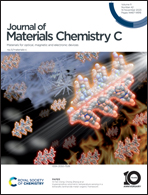Thermoelectric properties of Pnma and R3m GeS and GeSe†
Abstract
With ∼60% of global energy lost as heat, technologies such as thermoelectric generators (TEGs) are an important route to enhancing the efficiency of energy-intensive processes. Optimising thermoelectric (TE) materials requires balancing a set of interdependent physical properties to meet efficiency, cost and sustainability requirements, and is a complex materials-design challenge. In this study, we demonstrate a fully first-principles modelling approach to calculating the properties and thermoelectric figure of merit ZT and apply it to the orthorhombic and rhombohedral phases of GeS and GeSe. While p-doped Pnma GeS and GeSe do not match the performance of the Sn analogues, due to a smaller electrical conductivity σ and larger lattice thermal conductivity κlatt, we predict a large ZTmax = 2.12 for n-doped Pnma GeSe at 900 K, which would make it a good match for p-type SnSe in a thermoelectric couple. Moreover, with n-type doping the σ is largest along the layering direction and aligns with the minimum κlatt, and a much larger ZTmax > 3 could potentially be accessible with control over the growth direction. We also predict that p-doped R3m GeS and GeSe can achieve an industrially-viable ZT > 1, through a high σ counterbalanced by a large thermal conductivity, and experiments indicate this can be further improved by alloying. Our results therefore strongly motivate further study of the under-explored Ge chalcogenides as prospective TEs, with a particular focus on strategies for n-doping the Pnma phases.



 Please wait while we load your content...
Please wait while we load your content...